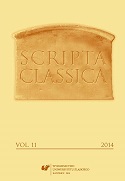The Oath in the Ancient and Medieval Culture. An Outline of the Problem
The Oath in the Ancient and Medieval Culture. An Outline of the Problem
Author(s): Lucyna Kostuch, Beata WojciechowskaSubject(s): Language and Literature Studies
Published by: Wydawnictwo Uniwersytetu Śląskiego
Keywords: oath; antiquity; the Middle Ages
Summary/Abstract: Since the ancient period the oath was a kind of religious act, a declaration of fixed content depending on the circumstances, intended to be delivered in public. It was a part of the agreements between states, tributes, strengthening treaties, meeting obligations, fulfilling obligations and promises. It was a means of evidence and a form of purification in court. It was sworn it public, according to a specific ritual and completed with set activities and while recalling the names of gods or God as witnesses. One of the ancient elements which survived the fall of the pagan world and was recorded in the medieval oath was undoubtedly the formula of the promise, which was divided into: a solemn declaration, a reference to a deity and a self-curse. The ancient and medieval perjurer was threatened with severe punishment – such a person could not find peace even after death. In both periods keeping oaths was the measure of one’s piety. The solemn commitment belonged to the realm of the sacred, as it was a part of a religious ritual. The basic gestures which accompanied the promise were of ancient origins – a hand raised to the sky and touching sacred objects.
Journal: Scripta Classica
- Issue Year: 2014
- Issue No: 11
- Page Range: 23-39
- Page Count: 17
- Language: English

